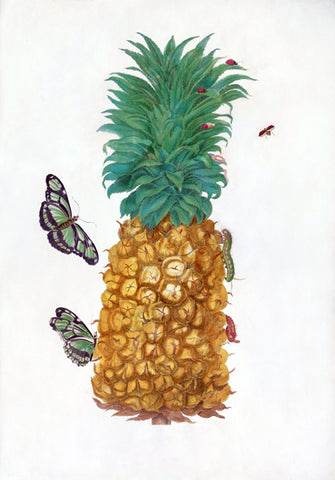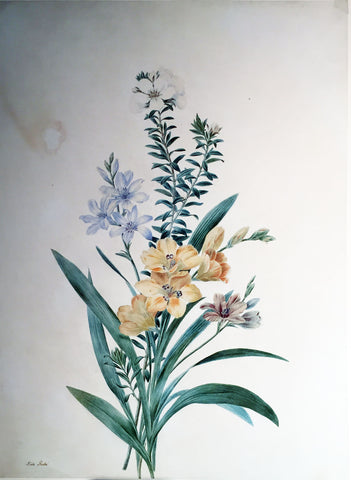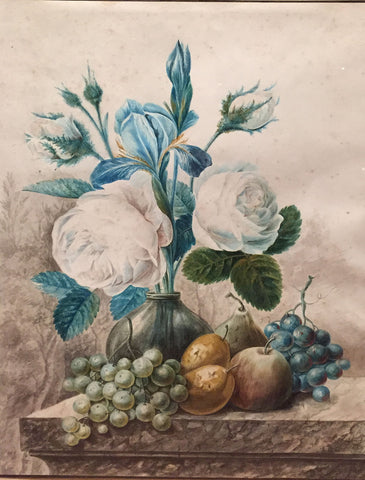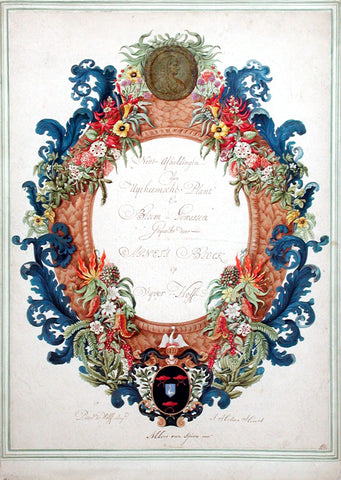
Maria Sibylla Merian (German, 1647-1717), Plate 2. The Pineapple Fruit
Maria Sibylla Merian (German, 1647-1717)
“Plate 2. The Pineapple Fruit”
from The Insects of Surinam
Watercolor and bodycolor with gum arabic over lightly etched outlines on paper
Amsterdam, 1705
Paper size: 20 1/4 x 14 in.
Transfer-print watercolors from The Insects of Surinam
The following is a clear example of how Merian’s visual and textual representations of Surinamese natural history do not attempt to force its bewildering abundance of sense impressions into a European system of classification that would deny these perceptions. The description of tactile sensations, qualities of taste and characteristics of odor link the visual sense with the remaining sensory apparatus, qualifying its position of predominance. Merian writes that if the pineapple is cut too thinly, “little hairs remain on it which penetrate the tongue when it is eaten and cause a great deal of pain. The fruit tastes like a mixture of grapes, apricots, currants, apples and pears, each flavor identifiable on the tongue at the same time. Its taste is sweet and strong. When the pineapple is cut open, the entire room is filled with its aroma.”
Descriptions of each plant adapted from J.Harvey’s commentary to the Folio Society facsimile of the Surinam Album (London, 2006) and Merian’s text for the Insects of Surinam.
One glimpse of any of Merian’s transfer-print watercolors from the Insects of Surinam reveals the main reasons for such celebration. Even to those who do not know of her work, this is a stunning sight. Her colors are alternately subtle and vibrant, capturing the quality of her subjects with striking naturalism. Yet while she maintains a scientist’s eye for precision, her creative decisions and compositions give these images a style that is distinctly hers. Each image demonstrates Merian’s masterful grasp of detail and nuance, as well as her outstanding ability to combine science and art. Equally significant, to early 18th century Europeans, her illustrations represented the first views of these American plants and insects.
These spectacular examples of her work are from one of a very few transfer-print watercolor volumes known to exist. Merian herself prepared the volume. After an uncolored print was made, she applied dampened paper to it, pressing by hand to create an image of the print in reverse. In this volume, she chose to block out the plate numbers and then add by hand, to some images, numbers, and notations. Merian then painstakingly watercolored the dried paper herself, ensuring that the colors were true to the specimens she had seen in South America, and also allowing her style to emerge with the greatest clarity. The volume was not meant for sale, and its intended purpose cannot be known with any certainty. Perhaps it was created as a gift for a wealthy and important patron, perhaps Merian meant to keep it herself. What can be stated without a doubt is that these splendid images represent a unique opportunity to acquire original works by an artist who broke barriers as a woman, as a scientist and artist, and whose accomplishments are no less impressive today than they were in her time.
Please feel free to contact us with questions by phone at 215.735.8811,
or by email at loricohen@aradergalleries.
We Also Recommend





